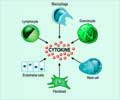Researchers have found evidence that disturbances in several immune-system-related pathways contribute to development of autism spectrum disorders.

"Others have talked about immune function contributions to autism, but in our study immune involvement has been identified through a completely nonbiased approach," says Vishal Saxena, PhD, of the Massachusetts General Hospital (MGH) Department of Neurology, first, corresponding and co-senior author of the PLOS ONE paper. "We let the data tell us what was most important; and most tellingly, viral infection pathways were most important in this immune-related mechanism behind autism."
Genetic studies of families including individuals with autism have indentified linkages with different locations in the genome. Since traditional interpretation methods implicate the gene closest to a marker site as the cause of a condition, those studies appeared to point to different genes affecting different families. However, Saxena's team realized that, since autism has typical symptoms and affects the same biological processes, a common molecular physiology must be affecting the different families studied. To search for genetic pathways incorporating these autism-associated sites, they developed a methodology called Linkage-ordered Gene Sets (LoGS) that analyzes all of the genes within a particular distance from marker sites and ranks them according to their distance from the marker.
Saxena's team first analyzed previously identified copy-number variants (CNVs) – deletions or duplications of large DNA segments – linked to autism, and identified associated pathways for the first time. After finding that the two pathways most frequently affected by CNVs in autism were related to immune function, they went on to identify three additional immune-related pathways among the top 20 sets of genes with autism-associated CNVs.
They then conducted LoGS analysis on the five CNV-identified pathways, which they called iCNV-5, along with 186 other pathways involved in a range of biologic functions, ranking them according to their distance from marker sites identified in family studies. Four of the five iCNV-5 pathways received the top four rankings in the LoGS analysis, strongly supporting an immune function role in autism. Additional pathways involved in neurodevelopment were highly ranked in both the CNV and LoGS analyses.
"The idea behind LoGS is akin to viewing a digital photograph," says Saxena, an instructor in Neurology at Harvard Medical School. "When one looks at a digital image from very close up, one only sees a few pixels and is unable to recognize the picture. Zooming out however, makes the picture understandable. In the same way, looking at single genes may lead to a disorganized view of a disease, but zooming out to the pathway level clarifies and unifies the mechanism."
Advertisement
Advertisement












